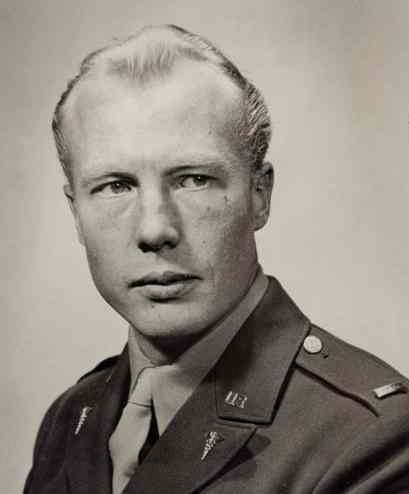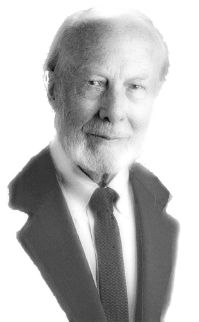WWII LARU oxygen rebreather
Dr. Christian J. Lambertsen received a B.S. Degree from Rutgers University in 1938 and a M.D. Degree from the University of Pennsylvania in 1943. During his medical school period, he invented and first used forms of the initial U.S. self-contained closed circuit oxygen rebreathing apparatus, for neutral buoyancy underwater swimming and diving. As a student, he aided the early Office of Strategic Services (O.S.S.) in establishing the first cadres of U.S. military operational combat swimmers. Dr. Lambertsen became an U.S. Army medical officer on graduation from medical school in early 1943, and immediately joined the O.S.S. Maritime Unit on active duty through its period of function in World War II. Responsibilities included OSS “Operational Swimmer Group” training and developing O.S.S. tactical functions combining self-contained diving and swimmer delivery, using a British one-man wet submersible.
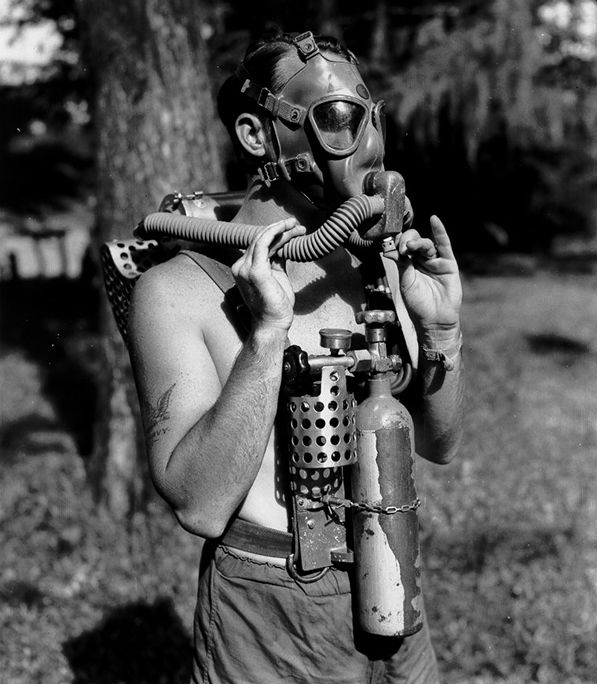
During the post World War II period, he trained U.S. Coast Guard, U.S. Army Engineers, and U.S. Navy Underwater Demolition Team cadres for submerged operations methods, including composite fleet submarine / operational swimmers activity. He joined the University of Pennsylvania Medical Faculty in 1946, and became Professor of Pharmacology in 1952. While a faculty member he combined diving research and further underwater rebreathing equipment developments for the Army and Navy. These activities included additional oxygen and mixed gas circuit rebreathing apparatus for potential use by military combat simmers and in underwater explosive ordinance disposal activity. Throughout the 1950’s Dr. Lambertsen served with several research advisory groups responding to the needs of the Department of Defense, Navy Undersea Warfare, and NASA Programs.
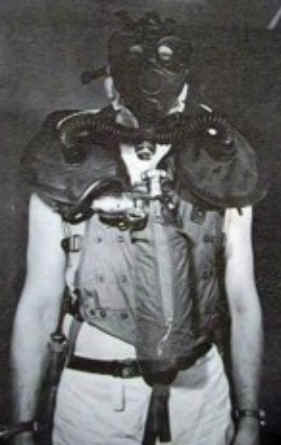
Beginning in 1964, he developed the University of Pennsylvania’s formal Institute for Environmental Medicine (IFEM) and established it’s companion Environmental Biomedical Stress Data Center (EBSDC), for international use in research relating human physiological stresses and capabilities in the environments of high altitude, undersea and aerospace activity. In 1967 he served as Founding President of the Undersea Medical Society (now Undersea and Hyperbaric Medical Society.) He has served in industrial technologic development functions in diving and aerospace fields as Life Science and Medical Advisor to McDonnell-Douglas Aircraft Corporation’s Mercury-Gemini Programs (1960 to 1967), Union Carbide Corp. (1960 to 1968), Air Products and Chemicals, Inc. (1973 to 1987), and Undersea Medical Advisor to Solus Ocean Systems, Inc. (1975 to 1983) and Sub-Sea International, Inc. (1983 to 1998). As a result of his pioneering work with the Office of Strategic Services and U.S. Navy Underwater Demolition Teams throughout the 1940’s and 1950’s, Dr. Lambertsen is recognized by the Naval Special Warfare community as “The Father of U.S. Combat Swimming.” His hand has touched every aspect of military and commercial diving. Dr. Lambertsen’s active contributions to diving began during WWII and became even more progressive in the post-war period through the evolutions of the U.S. Navy Deep Submergence and Naval Special Warfare developmental programs. He continues the University of Pennsylvania roles of Founding Director of the IFEM and the EBSDC and Professor of Environmental Medicine and serves on the U.S. Special Operations Command Medical Advisory Panel (MAP) for the Advanced SEAL Delivery System (ASDS).
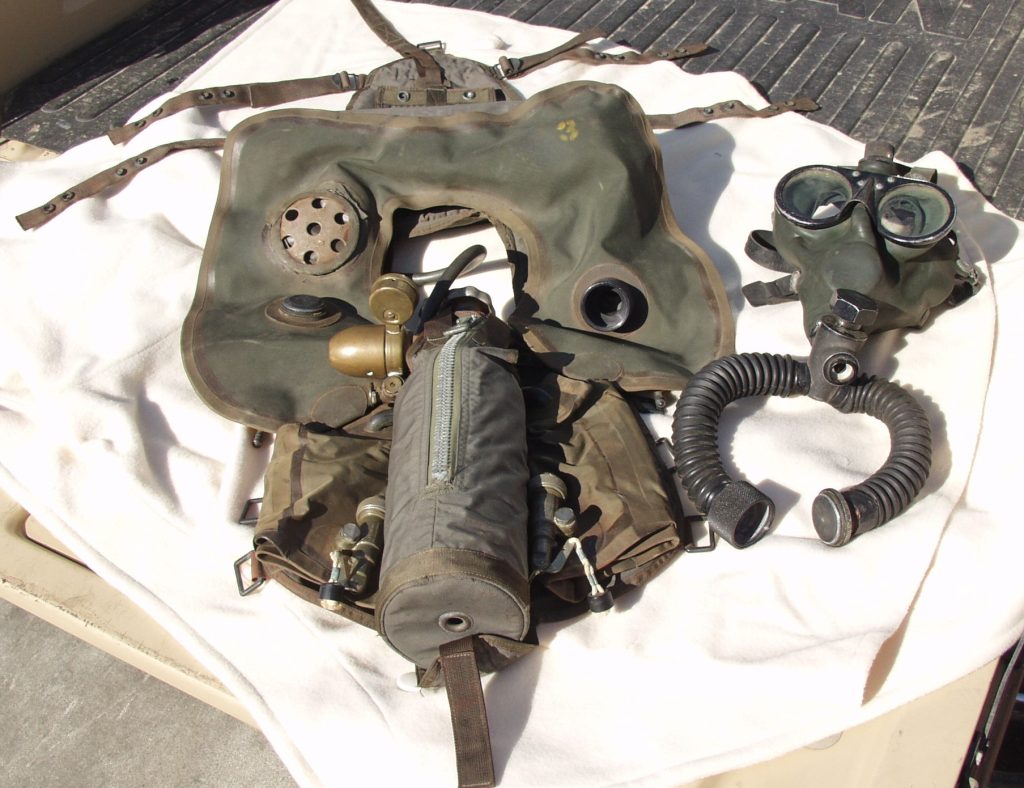
Christian J. Lambertsen
“Father of US Combat Swimming”
Christian became known as the “Father of US Combat Swimming in 2000, when the US Navy SEALs honored Christian with the title. In 2009, Dr. Lambertsen received the OSS Distinguished Service Award from the OSS Society for enabling the OSS to conduct “previously impossible missions.”
Christian spent his final years on Maryland’s Eastern shore raising cattle and tending to his honeybees and garden. He died in 2011 at the age of 93.
In a fitting commemoration to the “Father of the Frogmen,” Christian’s ashes were spread over the clear, warm waters off Key West, Florida.
Sleeping Beauty
Sleeping BeautyAnother underwater apparatus Christian helped advance was the motorized submersible canoe, nicknamed: Sleeping Beauty.The ‘Sleeping Beauty’ submersible canoe was built by the British SOE to hold a single frogman to conduct clandestine reconnaissance or attacks against enemy vessels. It earned its nickname when a British officer walked past the canoe and found its creator asleep in the craft.
The canoe was 12 feet 8 inches long and the navigator could expect to spend 10 hours or more in the vessel when on a mission.
The top secret canoe was brought to the US in 1944, and Christian began an intense program to train the OSS on how to use the boat; but not before he adjusted its tactical use.
Sleeping BeautyInstead of navigating the vehicle directly up to a target, he trained the swimmers to anchor the canoe within several hundred yards of the target. From there the frogman would swim to the target, place the demolition charge on it and swim back to the Sleeping Beauty.This concept paved the way for the swimmer delivery vehicle – used by the Navy’s UDTs and SEALs – years later.

Christian J. Lambertsen
Emeritus Distinguished Professor of Environmental Medicine Founder, Institute for Environmental Medicine
Research Interests
Acute and sustained adaptations to natural and synthetic respiratory environments at rest and at work. Control of internal oxygen and acid-base environments. Extension of tolerance to oxygen and hypoxia in clinical, atmospheric, undersea and aerospace circumstances. Gas narcosis, density, and toxic effects. Decompression and isobaric gas lesion diseases. Measurement of limits of human physical, physiologic and cognitive performance in extreme environments. Technology transfer through Environmental Biomedical Research Data Center.
Research Techniques
Dynamic measurement of human respiratory reactivity, blood and brain acid-base and oxygenation states. Mental, psychomotor and sensory performance measurement. Retinal electrical activity and visual evoked potential. Doppler monitoring of vascular gas embolism. Predictive modelling of interactions of environmental stress effects on physiologic functions.
Summary of Research Program
Use of altered environmental gases, pressures and temperatures to magnify and make measurable changes in fundamental respiratory, neural and cardiovascular functions, to elucidate normal regulatory mechanisms, and to study their disruption by graded exposures to environmental extremes. Development of advanced decompression procedures. Human beings are used as appropriate for the effects and mechanisms examined. Chemical, electrical, flow, histopathology, neuromuscular functions and mental functions are employed to track isolated or concurrent effects of purposeful activity or external physical or chemical stress. Research emphasizes quantitative separation of effects of oxygen, pressure and inert gas components upon specific tissue and organ functions. Measurements of effect are followed by study of methods to prevent or extend tolerance to effects (e.g., hyperoxia, hypoxia, narcosis). Results are applicable to clinical use of oxygen and hyperbaric oxygen therapy, to manned undersea and aerospace activity, synthetic biologic fluids, anesthesia, and influences of drugs upon mental and physical functions.
Key References
Lambertsen, C.J. and J. Idicula. A new gas lesion syndrome in man, induced by “isobaric gas counter-diffusion.” J. Appl. Physiol. 39: 434-443, 1975.
Lambertsen, C.J. Extension of oxygen tolerance: the philosophy and significance. In: Symposium on Extension of Oxygen Tolerance. Exper. Lung Res. 14 (Suppl.): 1035-1058, 1992.
Lambertsen, C.J., M.L. Gernhardt, R.G. Miller, and E. Hopkin. Development of decompression procedures. Based upon integrated analytic models of tissue gas bubble dynamics and oxygen tolerance, Environmental Biomedical Research Data Center Report No. 28.7.92, Institute for Environmental Medicine, University of Pennsylvania Medical Center.
Christian J. Lambertsen, M.D., D.Sc. (Hon)
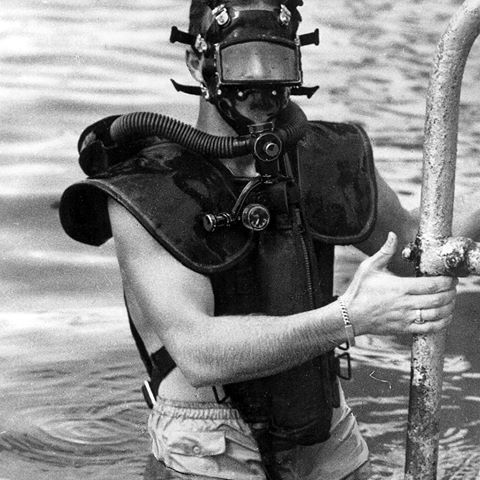

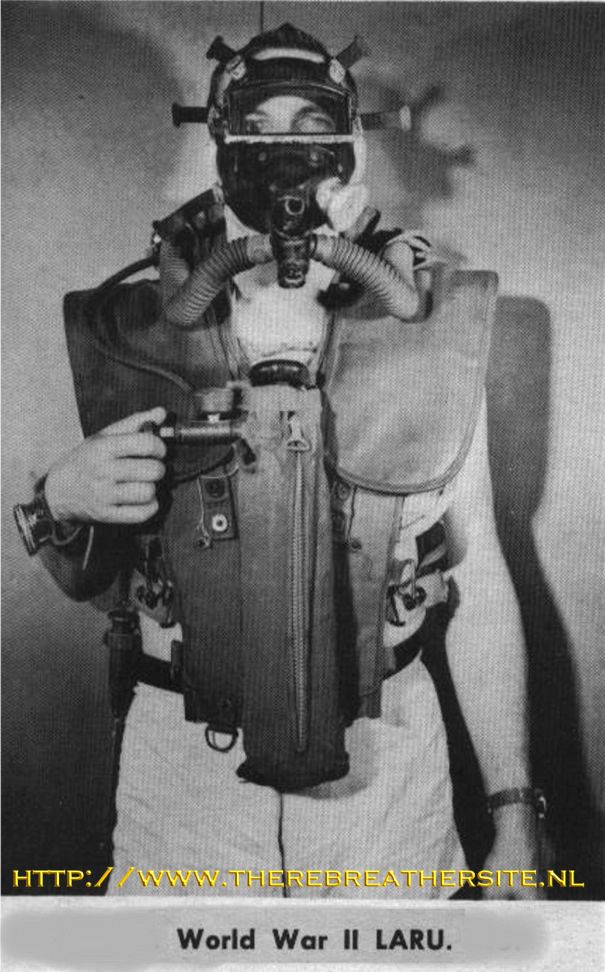
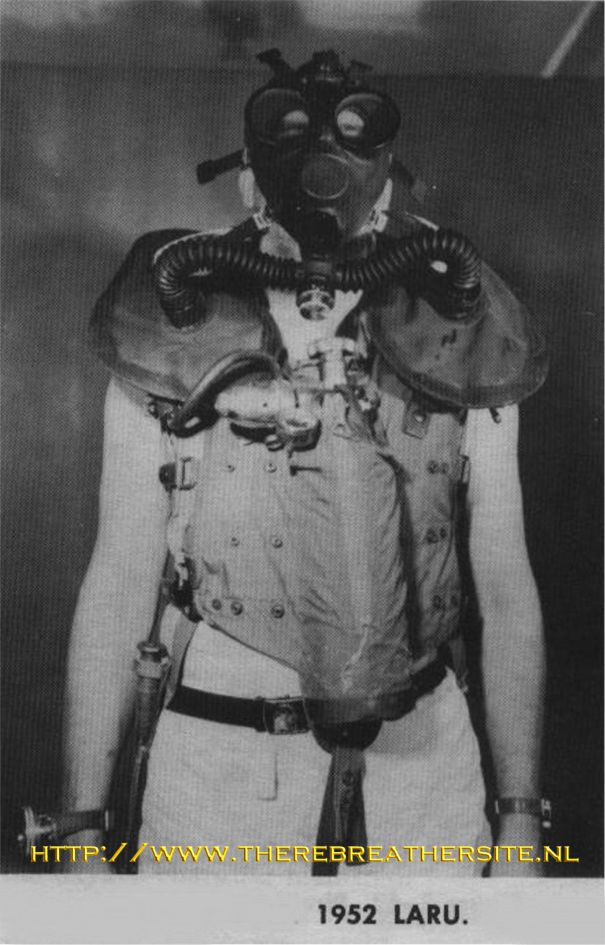
Lambertsen LARU Patent:
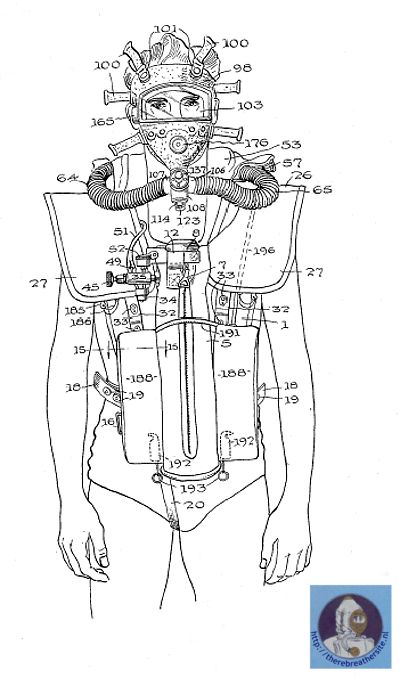
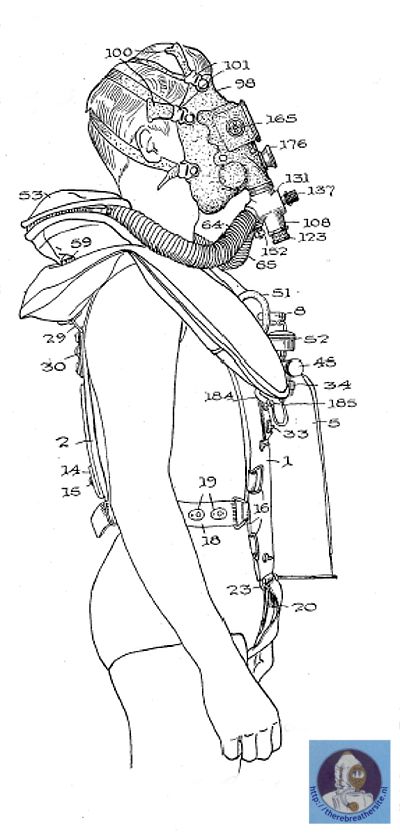
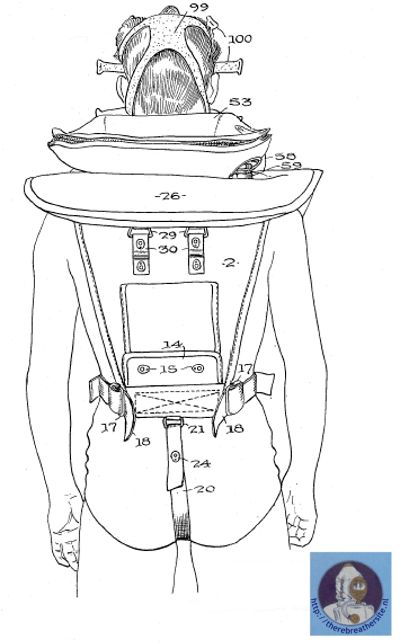
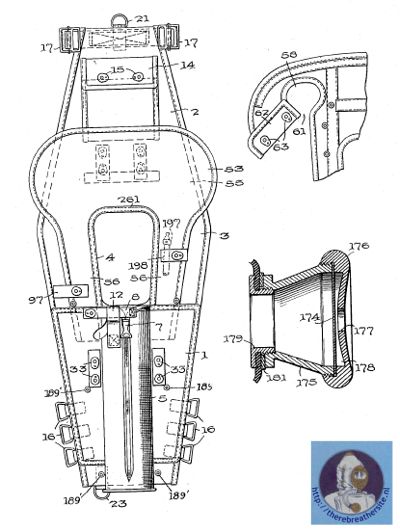
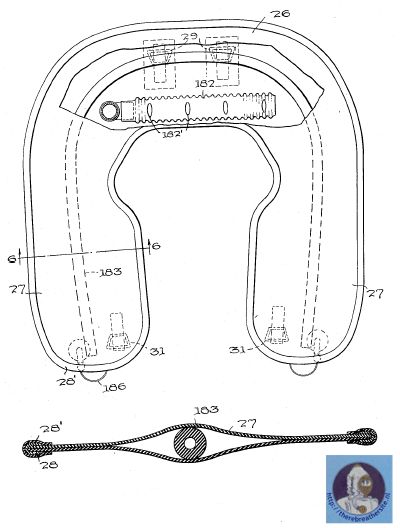

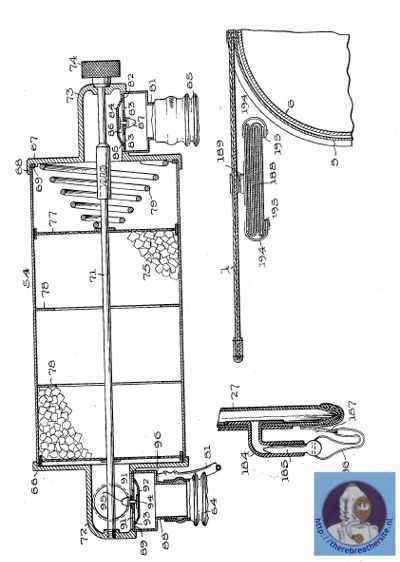
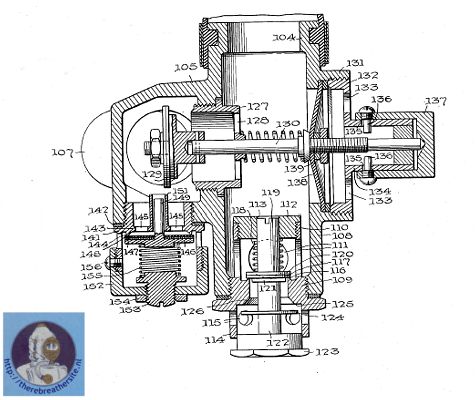
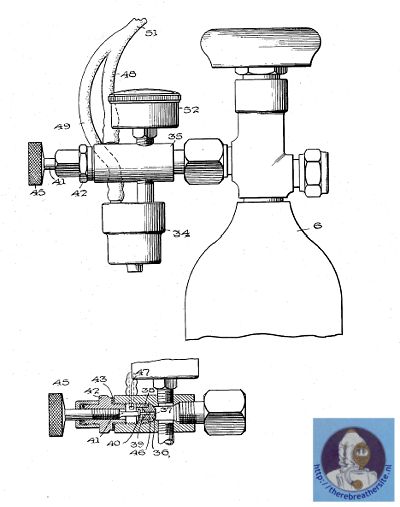
Lambertsen has patented his invention under US: 2456130A for full details

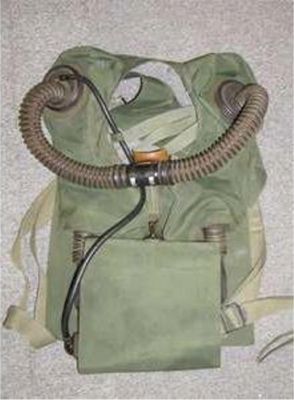
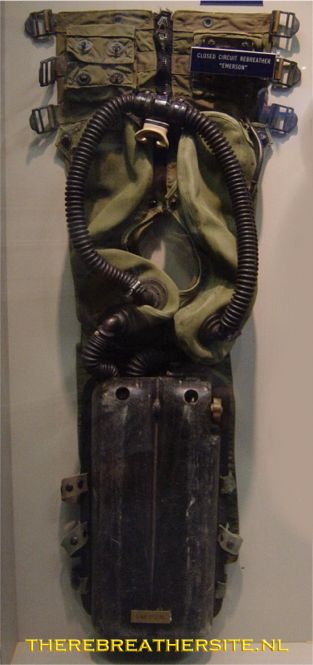

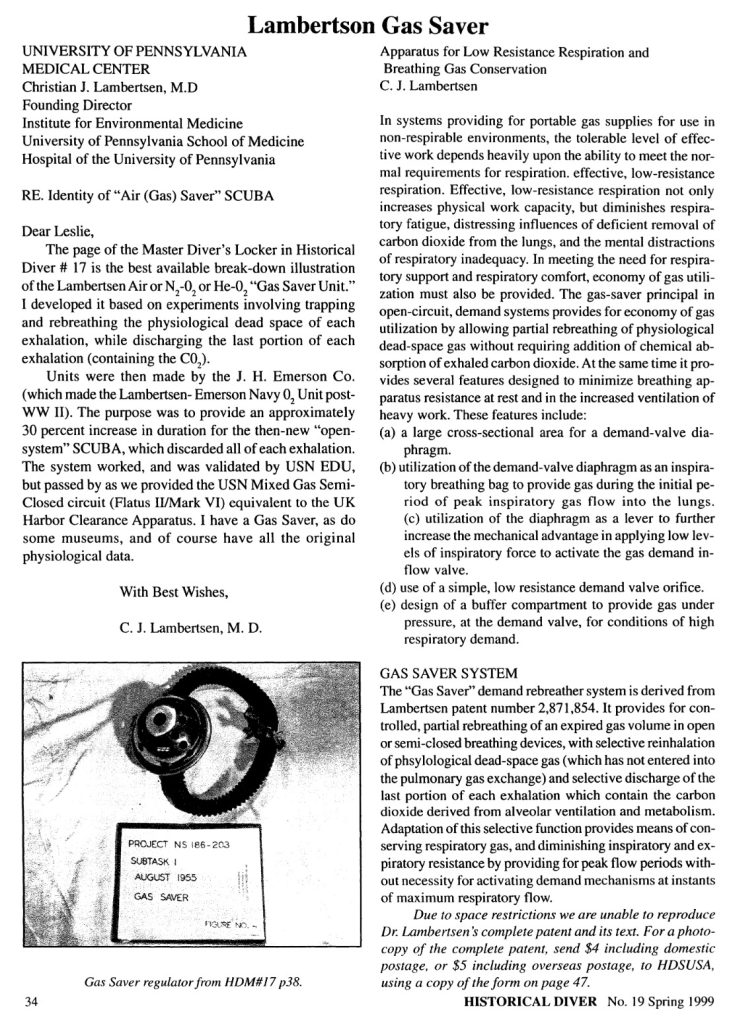
De tweede PDF gaat over de Lambertsen Gas Saver Unit. Ontwikkeld in 1955. Het open-circuit systeem voor ziet in een demand-systeem met besparing van gas door gedeeltelijk het gas uit de dode ruimte her te gebruiken. Tevens verlaagd het systeem de ademweerstand. Lees meer in de tweede PDF.

Therebreathersite was founded by Jan Willem Bech in 1999. After a diving career of many years, he decided to start technical diving in 1999. He immediately noticed that at that time there was almost no website that contained the history of closed breathing systems. The start for the website led to a huge collection that offered about 1,300 pages of information until 2019. In 2019, a fresh start was made with the website now freely available online for everyone. Therebreathersite is a source of information for divers, researchers, technicians and students. I hope you enjoy browsing the content!

